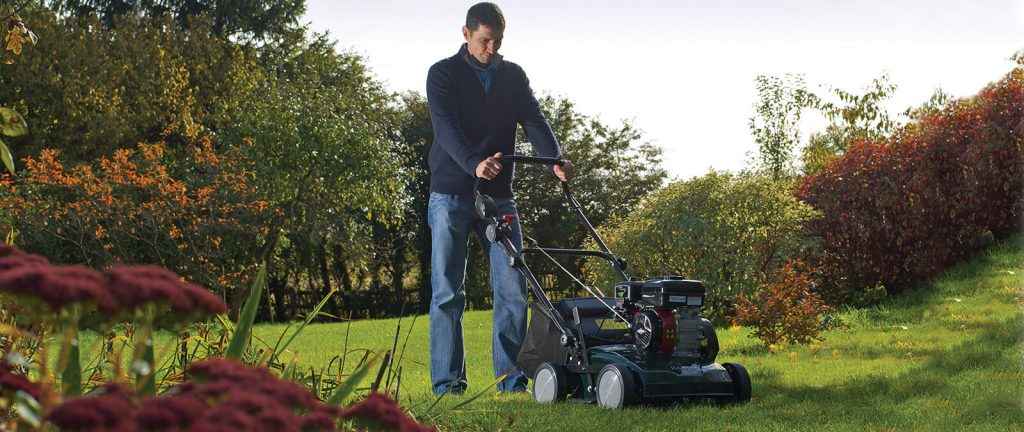Controlling the build-up of lawn thatch or removing it entirely requires you to scarify.
This can be done by raking or de-thatching.
The important part is knowing when to scarify, as well as how to do it properly.
Scarify at the right time of year and your lawn will recover quickly and reap the benefits.
Scarify at the wrong time of year and you’ll be creating many problems.
This guide will remove all doubt over when to scarify.
The Best Time to Scarify Your Lawn
Scarification is an important part of your lawn care regime, but it can make an absolute mess.
If you have severe thatch on your lawn, there’s a possibility of losing most or all grass coverage.
But with some time and effort, after recovery from initial damage, you will be left with a lawn that has never looked better.
The key is to only scarify at certain times of the year, as this will provide the best conditions for recovery, which are sun, warmth, and rain.
You can rake or de-thatch as required, but the time of year will influence what you do and when.
Spring: The Best Time for Light Scarification By Raking
Spring is always the best time for light scarification with the aim of controlling the build-up of lawn thatch. You can use a springbok rake or a powered scarifier with a spring tine cartridge attachment.
Raking is associated with moss removal, but you can also rake to remove the top layer of your lawn before it turns into thatch. This top layer is just organic material such as dead grass.
Doing it this way is far more gentle than heavy scarification which uses vertical blades. Recovery will be much quicker.
April has the best conditions for grass growth due to lots of sun and rain, which is why spring is the best time to complete this task.
Scarify lightly in April providing it isn’t too wet. If it is, wait until May instead.
Once June is here, your lawn will have already recovered and will look great.
Autumn: The Best Time for Heavy De-Thatching
If your lawn contains a lot of thatch, you’ll need to scarify heavily. As before, you can use a hand scarifier or a powered machine with the appropriate cartridge. These de-thatching cartridges contain vertical blades that cut deep into the lawn and tear out dead material.
If you’re in this position, wait until September as autumn is the best time of year.
This process will result in thinning the grass out and leaving many bare patches throughout the lawn. This bare soil provides the chance to sow new grass seed but its also the perfect environment for weeds to take hold and spread.
In autumn, there are fewer seed heads around so there is a smaller chance of suffering from a weed infestation. In spring, it is almost guaranteed that you will have a weed problem.
This is why we wait until autumn.
September is best because the soil is still warm, and rain is likely to become more frequent. This will assist with recovery.
Learn more: How To Sow New Grass Seed.
More Info About Scarifying Tools
You can either manually scarify or use a powered scarification machine. Your choice will likely depend on the size of your lawn.
Using a powered machine is much easier and far less hard work. You will avoid callouses and your back will thank you for it.
The best lawn scarifiers have swappable cartridges for raking and scarifying or de-thatching.

When NOT to Scarify Your Lawn
Most gardeners do a great job when scarifying their lawns.
But unfortunately, they usually do it at the wrong time of year or in poor weather conditions.
The result is that some lawns struggle to recover for years.
This is why you need to know when not to scarify your lawn too.
October
Because temperatures start to fall and grass growth slows, October is a bad month for lawn scarifying. Wet weather also causes moss spores to spread across your garden where they will settle into bare patches.
November to February
It is far too cold to scarify in winter so don’t bother trying.
Grass goes dormant in the winter and growth stops. This means your lawn won’t recover. This will likely result in:
- Moss invasions
- Soil frost heave
- A dead lawn
March
It is also too cold to scarify in March.
Despite the sunshine, the ground is still cold, and frost is still likely at this time of year. This frost could cause long lasting damage.
If moss has taken hold in your lawn, apply a moss killer now so it will have time to work before April.
June, July & August
It is now too hot and dry to scarify during summer.
Grass growth slows so it won’t be able to recover. The exposed soil will dry out due to excess heat which can kill your lawn.
The end result is a sparse, dry lawn.
Final Verdict
Like most things in gardening, scarifying is time sensitive.
Scarify your lawn at the right time of year and it will recover quickly, looking better than ever in the process.
Scarify your lawn at the wrong time of year and you could ruin your lawn. At best, you will spend a lot of time and effort fixing it.
Always keep an eye on the weather and get your timing right.